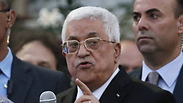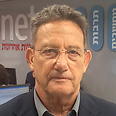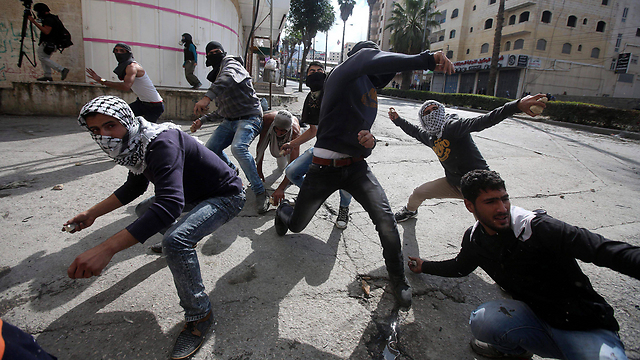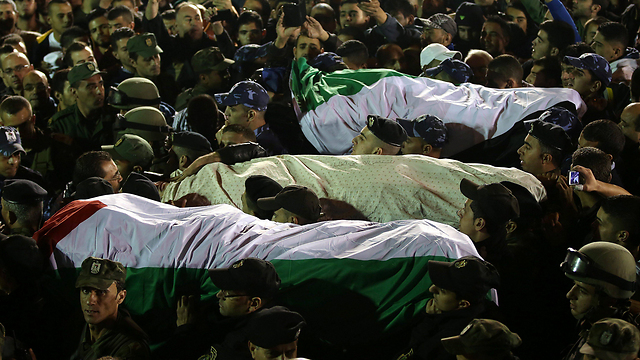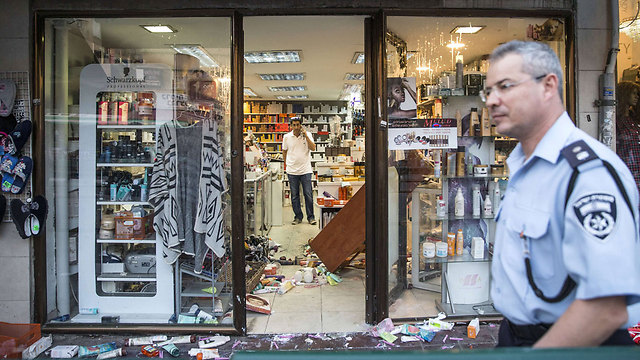
Abbas inciting with one hand, restraining with the other
Analysis: The Palestinian elements fanning the flames of terror and pushing stabbers on the streets are the same ones working intensively to prevent an escalation. This absurd situation has prevented the wave of terror from turning into a real intifada, but what will happen if Fatah's militant faction joins in?
This is a strange phenomenon, as the elements which are inciting and pushing the stabbers and drivers to the streets are the mostly the same ones who are working intensively, and quite sophisticatedly, to prevent an escalation. This absurd dichotomy has prevented the wave of terror from turning into a real intifada.
Another phenomenon we should pay attention to, which also involves a mirror image, is the panic on the Israeli street and the fact that it serves as the rewarding factor for the stabbers and drivers in vehicular attacks, and pushes more Palestinians to try to imitate their success.
Facebook and Twitter and Instagram, which turn the stabbers into national-religious heroes and celebrities, are another reward jihadists never expected in the past. Today's stabber - whether killed or wounded or even one who escapes unharmed - becomes an instant hero, and that encourages other angry young people to go out on the streets and look for a soldiers, settlers or any other Jew in order to take their anger out on them and become not just "shahidim" (martyr), but social heroes too.
This is the face of the current wave of terror and its unique characteristics. On the one hand, it isn't ending and doesn’t appear to be dying down. Every day there are two or three stabbing attacks or attempted stabbings, and occasionally vehicular attacks as well. On the other hand, the religious motive has faded away, and the friction with the settlers in Hebron - along with the fear demonstrated by the Israeli street - are maintaining a more or less fixed level of violence, mainly in the Hebron-Kiryat Arba-Gush Etzion Junction area.
Monday's stabbing attacks are no different. The terrorist who stabbed passersby in Rishon Lezion and seriously wounded two elderly people, is a young Hebron resident. The terror attack in Netanya, three hours later, was likely an imitation of the stabbings in Rishon Lezion. The fact that both attacks were carried out on Israeli territory within the Green Line is a mutation of the regular pattern that this wave of terror has taken on in the past month.
Abbas's strange efficiency
As I mentioned earlier, the elements fanning the flames are the restraining elements too. The main one is Hamas, which keeps on calling for days of rage and urging the Palestinian public to move to a general popular intifada, while at the same time firmly restraining the young Gazans who are provoking IDF soldiers on the border fence and making sure that things don't get out of control there. Two or three wounded Gazan teens a day are a tolerable number as far as Hamas in Gaza is concerned.
Hamas is also making sure that the "rebel" organizations don't fire rockets. Sometimes, a rocket slips under the Hamas gunmen's radar, but with the help of the Islamic Jihad and other organizations it is ensuring that there is no escalation in the street violence. On the other hand, Hamas is inciting to major violence in the West Bank, where it wants a full-scale intifada, and if possible an armed intifada.
Palestinian President Mahmoud Abbas, the Palestinian Authority and the Fatah movement are working simultaneously both to fan the flames and to restrain the crowds. The official Palestinian media outlets are inciting incessantly, and Abbas has provided us with some unforgettable performances too, including the tale about the executed 13-year-old boy, who at the same time was busy eating pudding in an Israeli hospital.
But the same Abbas, who talks about the Jews soiling al-Aqsa with their feet, has been working adamantly behind the scenes to prevent an escalation.
This duplicity is almost unbelievable. On the one hand, wild incitement which sends young people to stab and clash with Israel's security forces; and on the other hand, he is sending his security apparatus in civilian clothes, and sometimes in a real "disguise," to prevent the riots from turning into live-ammunition clashes and prevent thousands of young Palestinians from taking to the streets.
It should be noted that the elderly Palestinian leader is pretty efficient. The riots are talking place in regular "playgrounds" more or less with dozens or hundreds of participants at the most. Not thousands. And the most important thing is that Fatah's armed Tanzim men are still sitting at home and not joining the wave of violence and terror.
Fatah calls for third intifada
The third restraining element is the Israeli government's reserved policy, which orders the IDF to disrupt and deter terror - including rules of engagement which permit the killing of every terrorist with a knife in his hand - and at the same time to avoid disrupting the Palestinians' life fabric.
This policy is being led by Defense Minister Moshe Ya'alon and Chief of Staff Gadi Eisenkot, who are arguing - and rightfully so - that the terrorists, who must be targeted uncompromisingly, should be separated as much as possible from the population which is not joining and not helping them. The final goal is to return to a state of relative calm.
As part of this policy, the bodies of stabbing terrorists were returned in Hebron too, under the erroneous assumption that the Palestinians would honor their commitment to avoid inciting burial ceremonies, which fan the flames of the violence, and that the humanitarian gesture would advance calm.
It worked in small places, but in Hebron, the PA and Fatah - together with Hamas - held official burial ceremonies, which inspire the young Hebron residents to carry out further attacks. Let's hope that the defense establishment and security cabinet have learned the lesson: Terrorists' bodies should only be returned as part of an overall agreement, not in the midst of a wave of terror.
A recent development may presage a turn for the worse. On Monday, senior Fatah officials issued militant declarations, calling on the Palestinian public to launch a full popular intifada. At least one of these people is among Abbas's closest aides and a key Fatah figure. They didn't call for an armed intifada and for the use of live ammunition, but this is the first time that official Palestinian elements join Fatah in calling on the Palestinians to launch a third intifada.
Abbas explicitly said in recent weeks that he is against it, and these calls may be an act of defiance by Fatah members against his shaky leadership. In any event, if the Tanzim heeds these calls, which are being aired on official Palestinian television, we may find ourselves in a completely new situation - a third armed intifada with its fatal characteristics.













